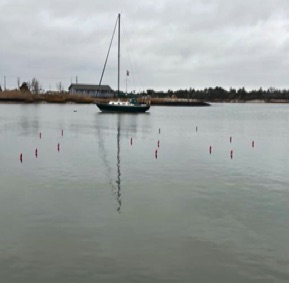Overview
The intrusion of seawater from the ocean into the mouth of rivers depends on an array of processes like tides, storms, water runnoff and agricultural activity. Salt intrusion threatens industrial, agri/aquacultural, and commercial activitiies. Water quality standards dictate that a certain freshwater-saltwater interface is kept below a certain distance from the river's mouth. But accurate and timely measurement of salinity is a challenge.
As the effects of climate change intensify, there is an increased need for accurate and timely prediction and forecasting of environmental processes around coastal regions and estuaries. Existing observational infrastructure is not always adequate to provide the needed "environmental intelligence" at the required spatial and temporal resolution. More often than not, observational capability relies on sparse collections of static point-measurement stations, which in conjunction with well-parameterized computational models have been serving us reasonably well for short-to-mid horizon forecasting. These models, however, struggle to capture dynamic phenomena that evolve in small spatio-temporal scales. To monitor such phenomena and capture data at sufficient resolution to appropriately parameterize environmental models we need new observational capabilities that allow for rapid, in-situe, reconfigurable sensor deployments.
This project aims at developing mathematical and algorithmic frameworks and datasets, that enable the rapid deployment of reconfigurable robotic marine sensor networks for the detection and tracking of a range of dynamic environmental processes, including saltwater intrution in estuaries.
Outcomes
Publications:
Kleio Baxevani, Chanaka Bandara, and Herbert G. Tanner. Autonomous Surface Vehicle Swarms with Bifurcation-driven Multi-behavioral Dynamics. IEEE/MTS OCEANS 2025 Great Lakes, 2025 (to appear)
Ioannis Faros and Herbert G. Tanner. System Identification and Adaptive Input Estimation on a Jaiabot Micro Autonomous Underwater Vehicle. arXiv:2504.02005 [eess.SY], 2025
Chanaka Thushitha Bandara and Herbert G. Tanner. Marine Surface Vehicle Formations in Confined Environments. Authorea. March 31, 2025 (Preprint) https://doi.org/10.22541/au.174344440.08473840/v1.
Herbert G. Tanner, Chanaka Bandara, and Matthew C. Gyves. Partial System Identification and Sensor Fusion with the Jaiabot Micro Autonomous Underwater Vehicle. In Proceedings of the 2024 IEEE Mediterranean Conference on Control and Automation, pp. 167-172, 2024.
Data Sets & Code:
Funding Organization: USGS
Duration: 3 years
Budget : $303,182
Duration: 2023-2026


